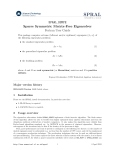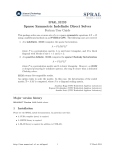Download SPRAL SCALING Sparse Matrix Scalings C User Guide
Transcript
SPRAL
SCALING v1.0.0
SPRAL SCALING
Sparse Matrix Scalings
C User Guide
This package generates various scalings (and matchings) of real sparse matrices.
Given a symmetric matrix A, it finds a diagonal matrix D such that the scaled
matrix
Aˆ = DAD
has specific numerical properties.
Given an unsymmetric or rectangular matrix A, it finds diagonal matrices Dr
and Dc such that the scaled matrix
Aˆ = Dr ADc
has specific numerical properties.
The specific numerical properties delivered depends on the algorithm used:
Matching-based algorithms scale A such that the maximum (absolute) value
in each row and column of Aˆ is exactly 1.0, where the entries of maximum
value form a maximum cardinality matching. The Hungarian algorithm
delivers an optimal matching slowly, whereas the auction algorithm delivers
an approximate matching quickly.
Norm-equilibration algorithms scale A such that the infinity norm of each row
and column of Aˆ is 1.0 ± τ (for some user specified tolerance τ ).
Jonathan Hogg (STFC Rutherford Appleton Laboratory)
Major version history
2014-12-17 Version 1.0.0 Initial public release
1
Installation
Please see the SPRAL install documentation.
2
Usage overview
2.1
Calling sequences
Access to the package requires inclusion of either spral.h (for the entire SPRAL library) or spral scaling.h
(for just the relevant routines). i.e.
#include "spral.h"
http://www.numerical.rl.ac.uk/spral
1
17 December 2014
SPRAL SCALING
Version 1.0.0
2
USAGE OVERVIEW
Figure 1: Data format example matrix (symmetric)
1.1 2.2
3.3
2.2
4.4
4.4
5.5
6.6
3.3
7.7 8.8
6.6 8.8 9.9
The following functions are available to the user:
• spral scaling default auction options() initializes the options structure for the auction algorithm.
• spral scaling default equilib options() initializes the options structure for the norm equilibriation
algorithm.
• spral scaling default hungarian options() initializes the options structure for the Hungarian algorithm.
• spral scaling auction sym() and spral scaling auction unsym() generate approximate matchingbased scalings for symmetric and unsymmetric/rectangular matrices respectively using an auction
algorithm.
• spral scaling equilib sym() and spral scaling equilib unsym() generate norm-equilibration scalings
for symmetric and unsymmetric/rectangular matrices respectively.
• spral scaling hungarian sym() and spral scaling hungarian unsym() generate matching-based
scalings for a symmetric and unsymmetric/rectangular matrices respectively using the Hungarian
algorithm.
2.2
2.2.1
Data formats
Compressed Sparse Column (CSC) Format
This standard data format consists of the following data:
int
int
int
int
double
m;
n;
ptr[ n+1 ];
row[ ptr[n]-1 ];
val[ ptr[n]-1 ];
/*
/*
/*
/*
/*
number of rows (unsymmetric matrix) */
number of columns */
column pointers */
row indices */
numerical values */
Non-zero matrix entries are ordered by increasing column index and stored in the arrays row[] and val[]
such that row[k] holds the row number and val[k] holds the value of the k-th entry. The ptr[] array stores
column pointers such that ptr[i] is the position in row[] and val[] of the first entry in the i-th column,
and ptr[n] is one more than the total number of entries. There must be no duplicate or out of range entries.
Entries that are zero, including those on the diagonal, need not be specified.
For symmetric matrices, only the lower triangular entries of A should be supplied. For unsymmetric
matrices, all entries in the matrix should be supplied.
Note that these routines offer no checking of user data, and the behaviour of these routines with
misformatted data is undefined.
To illustrate the CSC format, the following arrays describe the symmetric matrix shown in Figure 1.
int n = 5;
int ptr[]
= { 0,
3,
4,
6,
8,
9 };
int row[]
= { 0,
1,
3,
2,
2,
4,
3,
4,
4 };
double val[] = { 1.1, 2.2, 3.3, 4.4, 5.5, 6.6, 7.7, 8.8, 9.9 };
http://www.numerical.rl.ac.uk/spral
2
17 December 2014
SPRAL SCALING
3
Version 1.0.0
3
AUCTION ALGORITHM
Auction Algorithm
3.1
spral scaling auction default options()
To initialize a variable of type struct spral scaling auction options the following routine is
provided.
void spral scaling auction default options(struct spral scaling auction options *options);
*options is the instance to be initialized.
3.2
spral scaling auction sym()
To generate a scaling for a symmetric matrix using an auction algorithm such that the entry
of maximum absolute value in each row and column is approximately 1.0,
void spral_scaling_auction_sym(int n, const int *ptr, const int *row, const double *val,
double *scaling, int *match, const struct spral_scaling_auction_options *options,
struct spral_scaling_auction_inform *inform);
n, ptr[n+1], row[ptr[n]], val[ptr[n]] must hold the lower triangular part of A in compressed sparse
column format as described in Section 2.2.
scaling[n] holds, on exit, the diagonal of D. scaling[i] holds di , the scaling corresponding to the i-th
row and column.
match[m] may be NULL. If it is non-NULL, then on exit it specifies the matching of rows to columns. Row i
is matched to column match[i], or is unmatched if match[i]=-1.
*options specifies the algorithmic options used by the subroutine, as explained in Section 3.4.
*inform is used to return information about the execution of the subroutine, as explained in Section 3.5.
3.3
spral scaling auction unsym()
To generate a scaling for an unsymmetric or rectangular matrix using an auction algorithm
such that the entry of maximum absolute value in each row and column is approximately 1.0,
void spral_scaling_auction_unsym(int m, int n, const int *ptr, const int *row,
const double *val, double *rscaling, double *cscaling, int *match,
const struct spral_scaling_auction_options *options,
struct spral_scaling_auction_inform *inform);
m, n, ptr[n+1], row[ptr[n]], val[ptr[n]] must hold the lower triangular part of A in compressed sparse
column format as described in Section 2.2.
rscaling[m] holds, on exit, the diagonal of Dr . rscaling[i] holds dri , the scaling corresponding to the
i-th row.
cscaling[n] holds, on exit, the diagonal of Dc . cscaling[j] holds dcj , the scaling corresponding to the
j-th column.
match[m] may be NULL. If it is non-NULL, then on exit it specifies the matching of rows to columns. Row i
is matched to column match[i], or is unmatched if match[i]=-1.
*options specifies the algorithmic options used by the subroutine, as explained in Section 3.4.
*inform is used to return information about the execution of the subroutine, as explained in Section 3.5.
http://www.numerical.rl.ac.uk/spral
3
17 December 2014
SPRAL SCALING
3.4
Version 1.0.0
3
AUCTION ALGORITHM
struct spral scaling auction options
The structure spral scaling auction options is used to specify the options used by the routines
spral scaling auction sym() and spral scaling auction unsym(). The components, that must be given
default values through a call to spral scaling default auction options(), are:
int array base specifies the array indexing base. It must have the value either 0 (C indexing) or 1 (Fortran
indexing). If array base=1, the entries of arrays ptr[],row[] and match[] start at 1, not 0. Further,
entries of match[] that are unmatched are indicated by a value of 0, not -1. The default value is
array base=0.
float eps initial specifies the initial value of the minimum improvement parameter as described in
Section 3.7.
int max iterations specifies the maximum number of iterations the algorithm may perform. The default
is max iterations=30000.
int max unchanged[3] specifies, together with min proportion[], the termination conditions for the algorithm,
as described in Section 3.7. The default is max unchanged[] = { 10, 100, 100 }.
float min proportion[3] specifies, together with max unchanged(:), the termination conditions for the
algorithm, as described in Section 3.7. The default is min proportion[] = { 0.90, 0.0, 0.0 }.
3.5
struct spral scaling auction inform
The structure spral scaling auction inform is used to hold parameters that give information about
the progress of the routines spral scaling auction sym() and spral scaling auction unsym(). The
components are:
int flag gives the exit status of the algorithm (details in Section 3.6).
int iterations holds the number of iterations performed.
int matched holds the number of rows and columns that have been matched. As the algorithm may
terminate before a full matching is obtained, this only provides a lower bound on the structural rank.
int stat holds, in the event of an allocation error, the Fortran stat parameter if it is available (and is set
to 0 otherwise).
int unmatchable holds the number of columns designated as unmatchable. A column is designated as
unmatchable if there is no way to match it that improves the quality of the matching. It provides an
approximate lower bound on the structural rank deficiency.
3.6
Error Flags
A successful return from a routine is indicated by inform.flag having the value zero. A negative value is
associated with an error message.
Possible negative (error) values are:
-1 Allocation error. If available, the Fortran stat parameter is returned in inform.stat.
3.7
Algorithm description
This algorithm finds a fast approximation to the matching and scaling produced by the HSL package MC64.
If an optimal matching is required, use the Hungarian algorithm instead. The algorithm works by solving
the following maximum product optimization problem using an auction algorithm. The scaling is derived
from the dual variables associated with the solution.
Qm Qn
max
i=1
j=1 |aij |σij
σ
Pm
s.t.
σij = 1,
∀j = 1, n
Pni=1
∀i = 1, m
j=1 σij = 1,
σij ∈ {0, 1}.
http://www.numerical.rl.ac.uk/spral
4
17 December 2014
SPRAL SCALING
Version 1.0.0
3
AUCTION ALGORITHM
The array σ gives a matching of rows to columns.
By using the transformation
wij = log cj − log |aij |,
where cj = maxi |aij |, the maximum product problem in aij is replaced by a minimum sum problem in
wij where all entries are positive. By standard optimization theory, there exist dual variables u and v
corresponding to the constraints that satisfy the first order optimality conditions
wij − ui − vj = 0,
if σij = 1,
wij − ui − vj ≥ 0,
if σij = 0.
To obtain a scaling we define scaling matrices Dr and Dc as
dri = eui ,
dci = evi .
If a symmetric scaling is required, we average these as
p
di = dri dci .
By the first order optimality conditions, these scaling matrices guarantee that
dri |aij |dcj = 1,
if σij = 1,
dri |aij |dcj
if σij = 0.
≤ 1,
To solve the minimum sum problem an auction algorithm is used. The algorithm is not guaranteed to find
an optimal matching. However it can find an approximate matching very quickly. A matching is maintained
along with the row pricing vector u. In each major iteration, we loop over each column in turn. If the column
j is unmatched, we calculate the value pi = wij − ui for each entry and find the maximum across the column.
If this maximum is positive, the current matching can be improved by matching column j with row i. This
may mean that the previous match of row i now becomes unmatched. We update the price of row i, that is
ui , to reflect this new benefit and continue to the next column.
To prevent incremental shuffling, we insist that the value of adding a new column is at least a threshold
value above zero, where is based on the last iteration in which row i changed its match. This is done by
adding to the price ui , where = options.eps initial + itr/(n + 1), where itr is the current iteration
number.
The algorithm terminates if any of the following are satisfied:
• All entries are matched.
• The number of major iterations exceeds options.max iterations.
• At least options.max unchanged[0] iterations have passed without the cardinality of the matching
increasing, and the proportion of matched columns is options.min proportion[0].
• At least options.max unchanged[1] iterations have passed without the cardinality of the matching
increasing, and the proportion of matched columns is options.min proportion[1].
• At least options.max unchanged[2] iterations have passed without the cardinality of the matching
increasing, and the proportion of matched columns is options.min proportion[2].
The different combinations given by options.max unchanged[0:2] and options.min proportion[0:2]
allow a wide range of termination heuristics to be specified by the user depending on their particular needs.
Note that the matching and scaling produced will always be approximate as is non-zero.
Further details are given in the following paper:
[1] J.D. Hogg and J.A. Scott. (2014). On the efficient scaling of sparse symmetric matrices using an
auction algorithm. RAL Technical Report RAL-P-2014-002.
http://www.numerical.rl.ac.uk/spral
5
17 December 2014
SPRAL SCALING
3.8
Version 1.0.0
3
AUCTION ALGORITHM
Example of spral scaling auction sym()
The following code shows an example usage of spral scaling auction sym().
/* examples/C/scaling/auction_sym.f90 - Example code for SPRAL_SCALING */
#include <stdlib.h>
#include <stdio.h>
#include "spral.h"
void main(void) {
/* Derived types */
struct spral_scaling_auction_options options;
struct spral_scaling_auction_inform inform;
/* Other variables */
int match[5], i, j;
double scaling[5];
/* Data for symmetric matrix:
* ( 2 1
)
* ( 1 4 1
8 )
* (
1 3 2
)
* (
2
)
* (
8
2 ) */
int n = 5;
int ptr[]
= { 0,
2,
5,
7,7,
8 };
int row[]
= { 0,
1,
1,
2,
4,
2,
3,
4
};
double val[] = { 2.0, 1.0, 4.0, 1.0, 8.0, 3.0, 2.0, 2.0 };
printf("Initial matrix:\n");
spral_print_matrix(-1, SPRAL_MATRIX_REAL_SYM_INDEF, n, n, ptr, row, val, 0);
/* Perform symmetric scaling */
spral_scaling_auction_default_options(&options);
spral_scaling_auction_sym(n, ptr, row, val, scaling, match, &options, &inform);
if(inform.flag<0) {
printf("spral_scaling_auction_sym() returned with error %5d", inform.flag);
exit(1);
}
/* Print scaling and matching */
printf("Matching:");
for(int i=0; i<n; i++) printf(" %10d", match[i]);
printf("\nScaling: ");
for(int i=0; i<n; i++) printf(" %10.2le", scaling[i]);
printf("\n");
/* Calculate scaled matrix and print it */
for(int i=0; i<n; i++) {
for(int j=ptr[i]; j<ptr[i+1]; j++)
val[j] = scaling[row[j]] * val[j] * scaling[i];
}
printf("Scaled matrix:\n");
spral_print_matrix(-1, SPRAL_MATRIX_REAL_SYM_INDEF, n, n, ptr, row, val, 0);
}
http://www.numerical.rl.ac.uk/spral
6
17 December 2014
SPRAL SCALING
Version 1.0.0 4
NORM-EQUILIBRATION ALGORITHM
The above code produces the following output.
Initial matrix:
Real symmetric indefinite matrix, dimension
0:
2.0000E+00
1.0000E+00
1:
1.0000E+00
4.0000E+00
1.0000E+00
2:
1.0000E+00
3.0000E+00
3:
2.0000E+00
4:
8.0000E+00
Matching:
0
4
3
Scaling:
7.07e-01
1.62e-01
2.78e-01
Scaled matrix:
Real symmetric indefinite matrix, dimension
0:
1.0000E+00
1.1443E-01
1:
1.1443E-01
1.0476E-01
4.5008E-02
2:
4.5008E-02
2.3204E-01
3:
1.0000E+00
4:
1.0000E+00
4
5x5 with 8 entries.
8.0000E+00
2.0000E+00
2
1.80e+00
2.0000E+00
1
7.72e-01
5x5 with 8 entries.
1.0000E+00
1.0000E+00
1.1932E+00
Norm-equilibration algorithm
4.1
spral scaling equilib default options()
To initialize a variable of type struct spral scaling equilib options the following routine is
provided.
void spral scaling equilib default options(struct spral scaling equilib options *options);
*options is the instance to be initialized.
4.2
spral scaling equilib sym()
To generate a scaling for a symmetric matrix using a norm equilibration algorithm such that
the infinity norm of each row and column is equal to 1.0 ± τ ,
void spral_scaling_equilib_sym(int n, const int *ptr, const int *row, const double *val,
double *scaling, const struct spral_scaling_equilib_options *options,
struct spral_scaling_equilib_inform *inform);
n, ptr[n+1], row[ptr[n]], val[ptr[n]] must hold the lower triangular part of A in compressed sparse
column format as described in Section 2.2.
scaling[n] holds, on exit, the diagonal of D. scaling[i] holds di , the scaling corresponding to the i-th
row and column.
*options specifies the algorithmic options used by the subroutine, as explained in Section 4.4.
*inform is used to return information about the execution of the subroutine, as explained in Section 4.5.
4.3
spral scaling equilib unsym()
To generate a scaling for an unsymmetric or rectangular matrix using a norm equilibration
algorithm such that the infinity norm of each row and column is equal to 1.0 ± τ ,
void spral_scaling_equilib_unsym(int m, int n, const int *ptr, const int *row,
const double *val, double *rscaling, double *cscaling,
const struct spral_scaling_equilib_options *options,
struct spral_scaling_equilib_inform *inform);
m, n, ptr[n+1], row[ptr[n]], val[ptr[n]] must hold the lower triangular part of A in compressed sparse
column format as described in Section 2.2.
http://www.numerical.rl.ac.uk/spral
7
17 December 2014
SPRAL SCALING
Version 1.0.0 4
NORM-EQUILIBRATION ALGORITHM
rscaling[m] holds, on exit, the diagonal of Dr . scaling[i] holds dri , the scaling corresponding to the i-th
row.
cscaling[n] holds, on exit, the diagonal of Dc . scaling[j] holds dcj , the scaling corresponding to the j-th
column.
*options specifies the algorithmic options used by the subroutine, as explained in Section 4.4.
*inform is used to return information about the execution of the subroutine, as explained in Section 4.5.
4.4
struct spral scaling equilib options
The structure spral scaling equilib options is used to specify the options used by the routines
spral scaling equilib sym() and spral scaling equilib unsym(). The components, that must be given
default values through a call to spral scaling default equilib options(), are:
int array base specifies the array indexing base. It must have the value either 0 (C indexing) or 1 (Fortran
indexing). If array base=1, the entries of arrays ptr[] and row[] start at 1, not 0. The default value
is array base=0.
int max iterations specifies the maximum number of iterations the algorithm may perform. The default
is max iterations=10.
float tol specifies the convergence tolerance for the algorithm (though often termination is based on
max iterations). The default is tol = 1e-8.
4.5
struct spral scaling equilib inform
The structure spral scaling equilib inform is used to hold parameters that give information about
the progress of the routines spral scaling equilib sym() and spral scaling equilib unsym(). The
components are:
int flag gives the exit status of the algorithm (details in Section 4.6).
int iterations holds, on exit, the number of iterations performed.
int stat holds, in the event of an allocation error or deallocation error, the Fortran stat parameter if it is
available (and is set to 0 otherwise).
4.6
Error Flags
A successful return from a routine is indicated by inform.flag having the value zero. A negative value is
associated with an error message.
Possible negative (error) values are:
-1 Allocation error. If available, the Fortran stat parameter is returned in inform.stat.
4.7
Algorithm description
This algorithm is very similar to that used by the HSL routine MC77. An iterative method is used to scale the
infinity norm of both rows and columns to 1 with an asymptotic linear rate of convergence of 21 , preserving
symmetry if the matrix is symmetric.
For unsymmetric matrices, the algorithm outline is as follows:
(0)
(0)
Dr = I, Dc = I
for k = 1, options.max iterations do
(k−1)
(k−1)
A(k−1) = Dr
ADc
p
(k)
(k−1)
(Dr )ii = (Dr
)ii / maxj (A(k−1) )ij
p
(k)
(k−1)
(Dc )jj = (Dc
)jj / maxi (A(k−1) )ij
if (|1 − kA(k−1) kmax | ≤ options.tol) exit
http://www.numerical.rl.ac.uk/spral
8
17 December 2014
SPRAL SCALING
Version 1.0.0 4
NORM-EQUILIBRATION ALGORITHM
end for
(k)
(k)
For symmetric matrices, A(k−1) is symmetric, so Dr = Dc , and some operations can be skipped.
Further details are given in the following paper:
[2] P. Knight, D. Ruiz and B. Ucar. (2012). A symmetry preserving algorithm for matrix scaling. INRIA
Research Report 7552.
4.8
Example of spral scaling equilib sym()
The following code shows an example usage of spral scaling equilib sym().
/* examples/C/scaling/equilib_sym.f90 - Example code for SPRAL_SCALING */
#include <stdlib.h>
#include <stdio.h>
#include "spral.h"
void main(void) {
/* Derived types */
struct spral_scaling_equilib_options options;
struct spral_scaling_equilib_inform inform;
/* Other variables */
int i, j;
double scaling[5];
/* Data for symmetric matrix:
* ( 2 1
)
* ( 1 4 1
8 )
* (
1 3 2
)
* (
2
)
* (
8
2 ) */
int n = 5;
int ptr[]
= { 0,
2,
5,
7,7,
8 };
int row[]
= { 0,
1,
1,
2,
4,
2,
3,
4
};
double val[] = { 2.0, 1.0, 4.0, 1.0, 8.0, 3.0, 2.0, 2.0 };
printf("Initial matrix:\n");
spral_print_matrix(-1, SPRAL_MATRIX_REAL_SYM_INDEF, n, n, ptr, row, val, 0);
/* Perform symmetric scaling */
spral_scaling_equilib_default_options(&options);
spral_scaling_equilib_sym(n, ptr, row, val, scaling, &options, &inform);
if(inform.flag<0) {
printf("spral_scaling_equilib_sym() returned with error %5d", inform.flag);
exit(1);
}
/* Print scaling */
printf("Scaling: ");
for(int i=0; i<n; i++) printf(" %10.2le", scaling[i]);
printf("\n");
/* Calculate scaled matrix and print it */
for(int i=0; i<n; i++) {
for(int j=ptr[i]; j<ptr[i+1]; j++)
val[j] = scaling[row[j]] * val[j] * scaling[i];
}
printf("Scaled matrix:\n");
http://www.numerical.rl.ac.uk/spral
9
17 December 2014
SPRAL SCALING
Version 1.0.0
5
HUNGARIAN ALGORITHM
spral_print_matrix(-1, SPRAL_MATRIX_REAL_SYM_INDEF, n, n, ptr, row, val, 0);
}
The above code produces the following output.
Initial matrix:
Real symmetric indefinite matrix, dimension
0:
2.0000E+00
1.0000E+00
1:
1.0000E+00
4.0000E+00
1.0000E+00
2:
1.0000E+00
3.0000E+00
3:
2.0000E+00
4:
8.0000E+00
Scaling:
7.07e-01
3.54e-01
5.77e-01
Scaled matrix:
Real symmetric indefinite matrix, dimension
0:
1.0000E+00
2.5000E-01
1:
2.5000E-01
5.0000E-01
2.0412E-01
2:
2.0412E-01
1.0000E+00
3:
9.9960E-01
4:
1.0000E+00
5
5x5 with 8 entries.
8.0000E+00
2.0000E+00
8.66e-01
2.0000E+00
3.54e-01
5x5 with 8 entries.
1.0000E+00
9.9960E-01
2.5000E-01
Hungarian algorithm
5.1
spral scaling hungarian default options()
To initialize a variable of type struct spral scaling hungarian options the following routine is
provided.
void spral scaling hungarian default options(struct spral scaling hungarian options *options);
*options is the instance to be initialized.
5.2
spral scaling hungarian sym()
To generate a scaling for a symmetric matrix using the Hungarian algorithm such that the
entry of maximum absolute value in each row and column is 1.0,
void spral_scaling_hungarian_sym(int n, const int *ptr, const int *row, const double *val,
double *scaling, int *match, const struct spral_scaling_hungarian_options *options,
struct spral_scaling_hungarian_inform *inform);
n, ptr[n+1], row[ptr[n]], val[ptr[n]] must hold the lower triangular part of A in compressed sparse
column format as described in Section 2.2.
scaling[n] holds, on exit, the diagonal of D. scaling[i] holds Dii , the scaling corresponding to the i-th
row and column.
match[m] may be NULL. If it is non-NULL, then on exit it specifies the matching of rows to columns. Row i
is matched to column match[i], or is unmatched if match[i]=-1.
*options specifies the algorithmic options used by the subroutine, as explained in Section 5.4.
*inform is used to return information about the execution of the subroutine, as explained in Section 5.5.
5.3
spral scaling hungarian unsym()
To generate a scaling for an unsymmetric or rectangular matrix using the Hungarian algorithm
such that the entry of maximum absolute value in each row and column is 1.0,
http://www.numerical.rl.ac.uk/spral
10
17 December 2014
SPRAL SCALING
Version 1.0.0
5
HUNGARIAN ALGORITHM
void spral_scaling_hungarian_unsym(int m, int n, const int *ptr, const int *row,
const double *val, double *rscaling, double *cscaling, int *match,
const struct spral_scaling_hungarian_options *options,
struct spral_scaling_hungarian_inform *inform);
m, n, ptr[n+1], row[ptr[n]], val[ptr[n]] must hold the lower triangular part of A in compressed sparse
column format as described in Section 2.2.
rscaling[m] holds, on exit, the diagonal of Dr . rscaling[i] holds dri , the scaling corresponding to the
i-th row.
cscaling[n] holds, on exit, the diagonal of Dc . cscaling[j] holds dcj , the scaling corresponding to the
j-th column.
match[m] may be NULL. If it is non-NULL, then on exit it specifies the matching of rows to columns. Row i
is matched to column match[i], or is unmatched if match[i]=-1.
*options specifies the algorithmic options used by the subroutine, as explained in Section 5.4.
*inform is used to return information about the execution of the subroutine, as explained in Section 5.5.
5.4
struct spral scaling hungarian options
The structure spral scaling hungarian options is used to specify the options used by the routines
spral scaling hungarian sym() and spral scaling hungarian unsym(). The components, that must be
given default values through a call to spral scaling default hungarian options(), are:
int array base specifies the array indexing base. It must have the value either 0 (C indexing) or 1 (Fortran
indexing). If array base=1, the entries of arrays ptr[],row[] and match[] start at 1, not 0. Further,
entries of match[] that are unmatched are indicated by a value of 0, not -1. The default value is
array base=0.
bool scale if singular specifies whether scaling shuold continue if the matrix A is found to be structurally
singular. If scale if singular=true, and the A is structurally singular, a partial scaling corresponding
to a maximum cardinality matching will be returned and a warning issued. Otherwise an identity scaling
will be returned and an error issued.
5.5
struct spral scaling hungarian inform
The structure spral scaling hungarian inform is used to hold parameters that give information about the
progress of the routines spral scaling hungarian sym() and spral scaling hungarian unsym(). The
components are:
int flag gives the exit status of the algorithm (details in Section 5.6).
int matched holds the number of rows and columns that have been matched (i.e. the structural rank).
int stat holds, in the event of an allocation error or deallocation error, the Fortran stat parameter if it is
available (and is set to 0 otherwise).
5.6
Error Flags
A successful return from a routine is indicated by inform.flag having the value zero. A negative value is
associated with an error message and a positive value with a warning.
Possible negative (error) values are:
-1 Allocation error. If available, the Fortran stat parameter is returned in inform.stat.
-2 Matrix A is structurally rank-deficient. This error is returned only if options.scale if singular=false.
The scaling vector is set to 1.0 and a matching of maximum cardinality returned in the optional
argument match[], if present.
Possible positive (warning) values are:
+1 Matrix A is structurally rank-deficient. This warning is returned only if options.scale if singular=true.
http://www.numerical.rl.ac.uk/spral
11
17 December 2014
SPRAL SCALING
5.7
Version 1.0.0
5
HUNGARIAN ALGORITHM
Algorithm description
This algorithm is the same as used by the HSL package MC64. A scaling is derived from dual variables found
during the solution of the below maximum product optimization problem using the Hungarian algorithm.
Qm Qn
max
i=1
j=1 |aij |σij
σ
Pm
s.t.
σij = 1,
∀j = 1, n
Pni=1
∀i = 1, m
j=1 σij = 1,
σij ∈ {0, 1}.
The array σ gives a matching of rows to columns.
By using the transformation
wij = log cj − log |aij |,
where cj = maxi |aij |, the maximum product problem in aij is replaced by a minimum sum problem in
wij where all entries are positive. By standard optimization theory, there exist dual variables u and v
corresponding to the constraints that satisfy the first order optimality conditions
wij − ui − vj = 0,
if σij = 1,
wij − ui − vj ≥ 0,
if σij = 0.
To obtain a scaling we define scaling matrices Dr and Dc as
dri = eui ,
dci = evi .
If a symmetric scaling is required, we average these as
p
di = dri dci .
By the first order optimality conditions, these scaling matrices guarantee that
dri |aij |dcj = 1,
if σij = 1,
dri |aij |dcj
if σij = 0.
≤ 1,
To solve the minimum sum problem, the Hungarian algorithm maintains an optimal matching on a subset
of the rows and columns. It proceeds to grow this set by finding augmenting paths from an unmatched row to
an unmatched column. The algorithm is guaranteed to find the optimal solution in a fixed number of steps,
but can be very slow as it may need to explore the full matrix a number of times equal to the dimension of
the matrix. To minimize the solution time, a warmstarting heuristic is used to construct an initial optimal
subset matching.
Further details are given in the following paper:
[3] I.S. Duff and J. Koster. (1997). The design and use of algorithms for permuting large entries to the
diagonal of sparse matrices. SIAM J. Matrix Anal. Applics. 20(4), pp 889–901.
5.8
Example usage of spral scaling hungarian unsym()
The following code shows an example usage of hungarian scale unsym().
/* examples/C/scaling/hungarian_unsym.f90 - Example code for SPRAL_SCALING */
#include <stdlib.h>
#include <stdio.h>
#include "spral.h"
void main(void) {
/* Derived types */
struct spral_scaling_hungarian_options options;
struct spral_scaling_hungarian_inform inform;
http://www.numerical.rl.ac.uk/spral
12
17 December 2014
SPRAL SCALING
Version 1.0.0
5
HUNGARIAN ALGORITHM
/* Other variables */
int match[5], i, j;
double rscaling[5], cscaling[5];
/* Data for unsymmetric matrix:
* ( 2 5
)
* ( 1 4
7 )
* (
1
2
)
* (
3
)
* (
8
2 ) */
int m = 5, n = 5;
int ptr[]
= { 0,
2,
6,
7,
8,
10 };
int row[]
= { 0,
1,
0,
1,
2,
4,
3,
2,
1,
4
};
double val[] = { 2.0, 1.0, 5.0, 4.0, 1.0, 8.0, 3.0, 2.0, 7.0, 2.0 };
printf("Initial matrix:\n");
spral_print_matrix(-1, SPRAL_MATRIX_REAL_UNSYM, m, n, ptr, row, val, 0);
/* Perform symmetric scaling */
spral_scaling_hungarian_default_options(&options);
spral_scaling_hungarian_unsym(m, n, ptr, row, val, rscaling, cscaling, match,
&options, &inform);
if(inform.flag<0) {
printf("spral_scaling_hungarian_unsym() returned with error %5d", inform.flag);
exit(1);
}
/* Print scaling and matching */
printf("Matching:");
for(int i=0; i<n; i++) printf(" %10d", match[i]);
printf("\nRow Scaling: ");
for(int i=0; i<m; i++) printf(" %10.2le", rscaling[i]);
printf("\nCol Scaling: ");
for(int i=0; i<n; i++) printf(" %10.2le", cscaling[i]);
printf("\n");
/* Calculate scaled matrix and print it */
for(int i=0; i<n; i++) {
for(int j=ptr[i]; j<ptr[i+1]; j++)
val[j] = rscaling[row[j]] * val[j] * cscaling[i];
}
printf("Scaled matrix:\n");
spral_print_matrix(-1, SPRAL_MATRIX_REAL_UNSYM, m, n, ptr, row, val, 0);
}
The above code produces the following output.
Initial matrix:
Real unsymmetric matrix, dimension 5x5 with * entries.
0:
2.0000E+00
5.0000E+00
1:
1.0000E+00
4.0000E+00
7.0000E+00
2:
1.0000E+00
2.0000E+00
3:
3.0000E+00
4:
8.0000E+00
2.0000E+00
Matching:
0
4
3
2
1
Row Scaling:
5.22e-01
5.22e-01
5.22e-01
5.22e-01
5.22e-01
Col Scaling:
9.59e-01
2.40e-01
6.39e-01
9.59e-01
2.74e-01
Scaled matrix:
http://www.numerical.rl.ac.uk/spral
13
17 December 2014
SPRAL SCALING
Version 1.0.0
Real unsymmetric matrix, dimension 5x5 with * entries.
0:
1.0000E+00
6.2500E-01
1:
5.0000E-01
5.0000E-01
2:
1.2500E-01
1.0000E+00
3:
1.0000E+00
4:
1.0000E+00
http://www.numerical.rl.ac.uk/spral
14
5
HUNGARIAN ALGORITHM
1.0000E+00
2.8571E-01
17 December 2014

























